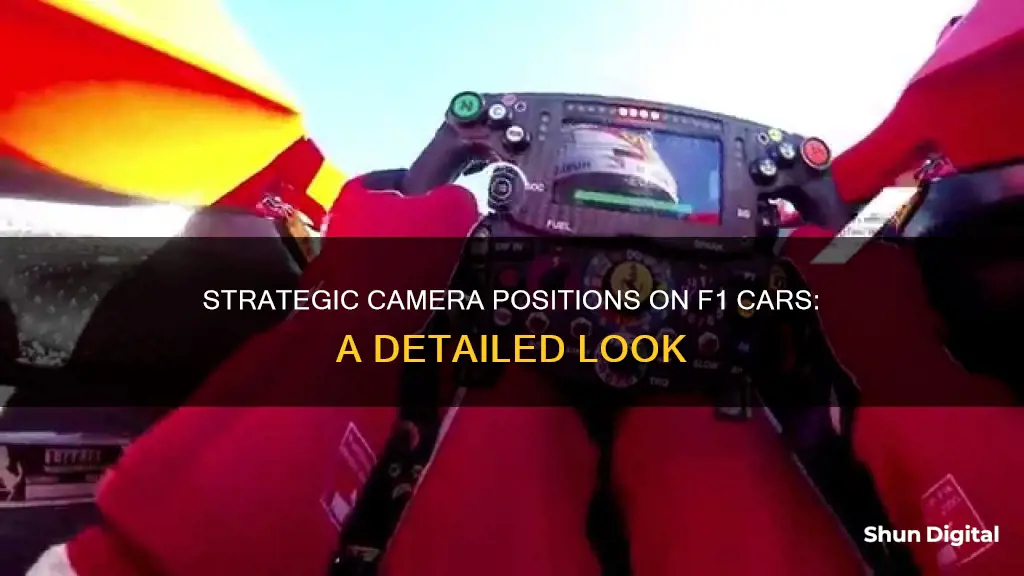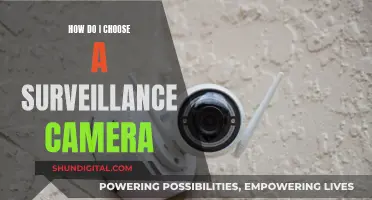
Onboard cameras have been a feature of F1 cars since the 1980s, providing fans with amazing footage of races from the driver's perspective. The camera angles and technology have become increasingly sophisticated over the years, and today, F1 cars have multiple camera mounting points, with cameras placed on the top of the airbox, the helmet, the front wing, and behind the pedals, among other locations. These cameras not only provide thrilling viewing experiences but also contribute to safety, with footage that can be reviewed after a race or an accident to improve safety measures. The placement of cameras on F1 cars has evolved over time, with a focus on enhancing the viewing experience, capturing unique footage, and ensuring the safety of drivers.
| Characteristics | Values |
|---|---|
| Number of cameras on each car | 6 |
| Number of camera mounting points | 2 |
| First mounting point location | On top of the air box immediately behind the driver's head |
| Second mounting point location | Chosen by the FIA in consultation with the team and driver |
| Camera footage use | On-board TV footage |
| Camera footage use | Displaying digital flags on the sides of the track |
| Camera footage use | Safety |
| Camera footage use | Social media |
| Camera footage storage | SD cards in the cameras |
| Camera footage storage | Stored inside the car |
What You'll Learn

Cameras on F1 cars are used for on-board TV footage
Each F1 car has multiple camera mounting points, with at least two FOM cameras or camera housings required. One camera is always positioned on top of the airbox, directly behind the driver's head. This camera housing captures the action from the cockpit, giving viewers a sense of what the driver experiences during the race.
The second camera housing location is determined through consultation between the FIA and the team and driver. This camera can be mounted on the front wing, rear wing, roll hoop, or other designated areas, ensuring a variety of viewpoints for television audiences.
In recent years, there has been a focus on improving the quality and placement of cameras. For example, the introduction of a gyroscope camera, mounted on the wings of F1 cars, provides viewers with a sensation of diving into corners, enhancing the excitement of the race.
The cameras also serve a safety purpose, as they can collect data and transmit information about flag signals, providing drivers with digital displays of flag colours in their cockpits. Additionally, cameras contribute to accident analysis, with footage used to understand and improve safety measures.
The placement of cameras on F1 cars is carefully considered, balancing the need for captivating visuals and ensuring the safety and performance of the vehicles. The evolution of camera technology in F1 continues to enhance the viewing experience for fans worldwide.
Surveillance Camera Resolution: 1080p vs 4K Clarity
You may want to see also

There are six camera mounting points on F1 cars
The six mounting points allow for cameras to be placed in various locations on the car, including the front wing, rear wing, roll hoop, and cockpit. The cameras provide onboard TV footage, giving viewers a unique perspective of the race and enhancing their viewing experience.
In addition to the cameras on the car, there may also be a small mini-camera placed in the driver's helmet, adding minimal extra weight and transmitting information through a cable connected to the car. This cable detaches easily for safety reasons if the driver needs to exit the car quickly.
The placement of cameras on F1 cars has evolved over time, with rules and regulations updated to ensure optimal camera positions for effective TV pictures without compromising aerodynamics and safety.
ReconYX Cameras: Where Are They Manufactured?
You may want to see also

The placement of one of the camera housings is chosen by the FIA
Formula One cars are equipped with a multitude of cameras, providing viewers with a range of perspectives and enhancing the viewing experience. One of the most notable camera placements is the one mandated by the FIA (Fédération Internationale de l'Automobile), the governing body of auto sports. This camera is positioned behind the driver's head, immediately above the airbox. The FIA, in consultation with the relevant team and driver, also selects the location of a second camera housing on the car. This collaborative process ensures that the optimal position is chosen, taking into account factors such as safety, aerodynamics, and the desired field of view.
The placement of the camera by the FIA serves multiple purposes. Firstly, it provides valuable footage for broadcasting, giving viewers a unique perspective of the race. This footage is utilised by broadcasters during telecasts, offering a glimpse into the cockpit and the driver's experience. Additionally, the cameras aid in safety. They are connected to a black box in the car, capturing crucial data and footage in the event of a crash. This information is invaluable for accident analysis and improving safety protocols.
The FIA has also introduced regulations to standardise camera placement and optimise their function. For instance, the FIA mandated that front-mounted camera pods be positioned between 325-525mm above the floor to minimise their aerodynamic influence on the car's performance. This rule was implemented after several teams strategically placed the camera pods to gain an aerodynamic advantage.
The FIA's involvement in camera placement extends beyond simply choosing the location. They also collaborate with other sports organisations to enhance the camera technology and viewing experience. For example, the gyroscope camera introduced in collaboration with MotoGP provides viewers with a unique sensation of diving into corners, enhancing the sense of speed and immersion.
The placement of one of the camera housings by the FIA, in consultation with the teams and drivers, ensures that the cameras capture the action effectively while also considering safety and performance implications. This collaborative approach allows for optimal camera placement, contributing to both the viewing experience and the overall safety of the sport.
Best Cameras for RAW Photography Enthusiasts
You may want to see also

F1 cars have cameras to aid safety and accident analysis
F1 cars have several cameras mounted on them, and they serve a variety of purposes, including safety and accident analysis, as well as providing spectacular footage for fans.
The use of onboard cameras in F1 cars was introduced in the 1980s, allowing fans to experience the thrill of riding alongside the driver for the first time. Over the years, the camera angles and technology have become more sophisticated, enhancing the viewing experience and also contributing to safety.
One example of a camera used for safety purposes is the "camera wing" mounted on top of the bolide, which has been a standard feature for years. This wing not only captures images from the cockpit, but also contains advanced technology and chips. These chips enable constant communication with mobile transmitters near the track, allowing the transmission of information such as flag signals, which are then displayed digitally in the driver's cockpit. This ensures that drivers receive critical information, such as yellow or red flag situations, in a timely manner.
In addition to the camera wing, F1 cars also have cameras mounted in other locations, such as the front and rear wings, the nose, and the roll hoop. These cameras provide valuable footage for analysis and broadcast. For instance, the nose camera captures images of the front wing, while the roll hoop camera offers a clear view of the car's surroundings. The positioning of these cameras is carefully considered to minimise any potential impact on the car's performance, such as by mandating a minimum height for the front cameras to reduce aerodynamic influence.
Furthermore, some F1 drivers also have small mini cameras mounted in their helmets, providing a unique perspective of the driver's experience. These helmet cameras are placed in the cushion of the helmet and are designed to add minimal extra weight, ensuring they do not obstruct the driver. The cable connecting the camera can easily detach in case of an emergency, prioritising the driver's safety.
The data and footage collected from these various cameras play a crucial role in safety and accident analysis. For instance, in the event of a crash, the black box in the car can provide valuable information and data to help understand what happened. This information can then be used to improve safety measures and protocols.
In summary, the cameras on F1 cars serve multiple purposes, including enhancing the viewing experience for fans, providing critical safety information to drivers, and aiding in safety and accident analysis. By utilising these cameras, F1 continues to innovate and improve the sport, ensuring the safety of the drivers and providing fans with spectacular and immersive footage.
Baby Car Camera Legality: What You Need to Know
You may want to see also

Teams can place their own cameras on cars during practice
During free practice sessions on Fridays at Grand Prix, teams can place their own cameras on cars. This is done to gather data and show how their latest updates are working. For example, during the 2012 season, Red Bull used an infrared or thermographic camera mounted on the right side of the engine cover to film the exhaust gas flow as it exited the exhausts and passed down into the diffuser, measuring and observing the Coanda effect. Some teams use a simple GoPro camera, mounted on the different parts of the bodywork, pointing at the different aero parts and observing them during free practice.
The teams can place their own cameras on the cars during practice to show how their latest updates are working. This is an opportunity to fine-tune the details of their innovations. Each car has a transponder unit with a unique ID that transmits data when the unit is energised by passing over a timing loop buried in the track surface. This allows timekeepers to record every lap time of every car throughout the weekend.
The FOM rules prohibit the use of video cameras in the circuit by non-TV rights holders, but there is a dispensation for teams on Friday mornings. This means that during free practice sessions, there may be more onboard cameras on the cars than the FIA prescribes. However, they are not all TV cameras placed there by Formula One Management.
How to Save Camera Raw Defaults for Future Use
You may want to see also







